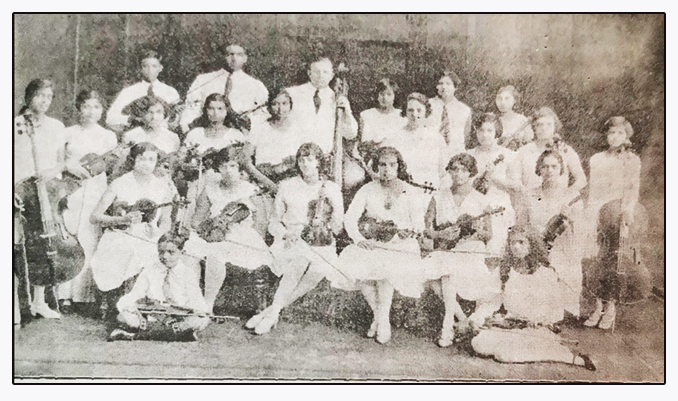FEATURES
FOUNDERS OF A GREAT MUSICAL TRADITION IN CEYLON, REMEMBERING MAJOR AND MRS WG ST CLAIR

Back Row, from left:Basil White, Corbett Jayewardene, Kai Nielson, Marjorie Bartholomeusz, Mrs Van Cuylenberg, Phyllis Arseculeratne. Middle Row; May Muttunayagam, Lennie Sandrasagara,Prienie Molamure,Charlemont Dias,Netta Muttunayagam, Mrs WG St Clair Evelyn Felsinger, Mrs EE Spencer, Beryl Bartholomeusz Seated: Rosemary van Houven, Ada Swan, ,Laurette De Zilwa, Mrs Caspersz, Mrs Jayetilleke, Rene de Franz Seated on ground: Basil Ferdinand, Audrey Dharmakirti.
THE WG ST CLAIR STUDENT ORCHESTRA 1930
by HUGH KARUNANAYAKE
Western music in Sri Lanka today is a broad musical canvas encompassing many musical genres such as the classics, pop, jazz, rock and roll etc. It is indeed a live entity drawing musicians of talent to meet the unceasing demand from an ever growing audience. Sri Lanka boasts a formidable musical culture which seems to be institutionalised and embedded within all classes and ethnicities.
At the turn of the twentieth century however, the musical scene was either non existent or bleak enough to be relegated into the backwoods of social activity. The intervention which sparked off the change could be attributed to the efforts of two persons Major and Mrs WG St Clair. Their names may not even evoke a nod of recognition in contemporary Sri Lanka, but in the 1920s and 30s, they were names to conjure with.
Major Graeme and Mrs St Clair arrived in Ceylon in 1920. Major St Clair was an organist and double bass player in Singapore, and was responsible for the formation of the Singapore Philharmonic Orchestra in 1891. Mrs St Clair was a pianist and violinist, was a member of the Orchestra and a popular music teacher. On Major St Clair’s retirement in 1916, they chose to settle down in Ceylon. Their life in Colombo was however hardly one of retirement.
Their home “Silverdawn” in Kollupitiya was the venue for music classes attended by children from Colombo’s leading schools. Mrs St Clair formed an orchestra called the ” Mrs WG St Clair Student Orchestra” in which many of the young performers were later to become leading musicians or teachers of music in Sri Lanka. The photograph here shows the members of the Orchestra at their performance in the Bishop’s College Hall on March 12, 1930. The orchestral renderings included “Moonlight Valse” by FH Klickman, Dvuraks “Humoresque”, Mendelsohn’s “March of the Priests”, “La Serenata” by Toselli, favourites such as ” Londonderry Air, and many others. The orchestra was backed by Major St Clair on double bass.
Many young faces, later to dominate the music scene in Sri Lanka either as musicians or as music teachers, could be seen in the photograph here. Standing at the extreme left of the back row is Basil White, later to be a lawyer and Crown Counsel, and a dramatist of no mean skill. Standing next to him is Corbett Jayewardene,a younger brother of former President JR Jayewardene and a man of many parts. He was a lawyer and a judge, a motor racing enthusiast, vocalist and dramatist, and on retirement was ordained as a Buddhist monk.
Third from left in the front row is Laurette de Zilwa, daughter of gynaecologist Dr Lucien de Zilwa, the first man in Ceylon to be named “Lucien”! At the age of 14 Laurettes was offered a scholarship to the Royal Academy, but her father did not send her as he felt that not having reached the London Matriculation level at that stage, her general education was not broad enough for her to specialise in music. Laurette lived in England reaching her nineties and was possibly the longest lived in this group.
Standing second from left in the middle row is Lennie Sandrasagara daughter of the famous lawyer of early twentieth Century, Mr HAP Sandrasagara. A former student of st Bridget’s Convent, she later married Dr AP Sandrasagara, a ENT specialist attached to the Chidren’s Hospital.
Seated on the ground at left is Douglas Ferdinand, who in later life was a leading violinist and conductor. He was a household name in musical circles and Director of the Colombo Symphony Orchestra for many years. On the ground on right is Audrey Dharmakirti who after marriage was known as Audrey Dharmakirti Peiris, an accomplished violinist and pianist performing in many recitals and concerts in Colombo.
What of the mentors of these pionner musicians? Major Graeme St Clair died in Colombo in 1931 unhonoured and literally unsung. Not the case however in Singapore, a country he left 15 years previously, to retire in Ceylon. On September 17, 1931,the Governor of Singapore Sir Cecil Clementi formally declared open the St Clair Organ in the Victoria Memorial Hall “to remember the late Major WG St Clair, who spent the last years of his life in Ceylon, and whose name has been given to this organ in remembrance of his long and unflagging efforts for the advancement of music in Singapore”.
Mrs St Clair passed away three years later in 1934. Their magnificent contribution to the cause of musical education may now be forgotten, but surely acknowledged through the glorious musical tradition left through her students and through them to subsequent generations of Sri Lankans.
